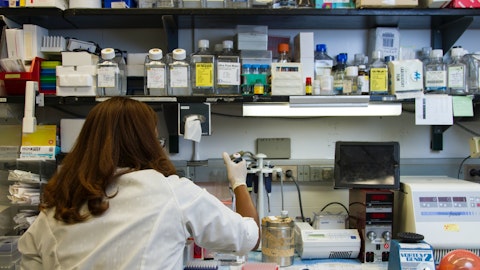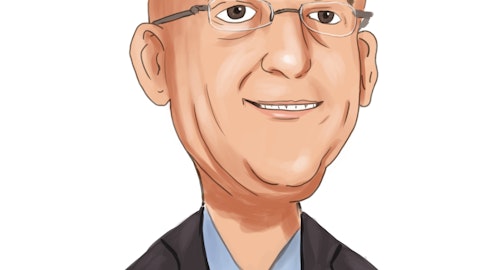Adaptimmune Therapeutics plc (NASDAQ:ADAP) Q3 2023 Earnings Call Transcript November 8, 2023
Operator: Good morning, ladies and gentlemen, and welcome to the Adaptimmune’s Q3 Financial and Business Update Conference Call. I would now like to turn the meeting over to Ms. Juli Miller. Please go ahead, Ms. Miller.
Juli Miller: Good morning, and welcome to Adaptimmune’s conference call to discuss our third quarter 2023 financial results and business updates. I would ask you to review the full text of our forward-looking statements from this morning’s press release. We anticipate making projections during this call and actual results could differ materially due to several factors, including those outlined in our latest filings with the SEC. Adrian Rawcliffe, our Chief Executive Officer; and Dennis Williams, our Senior Vice President of Late Stage Development, are here with me for the prepared portion of the call. Other members of our management team will be available for Q&A. With that, I’ll turn the call over to Adrian Rawcliffe. Ad?
Adrian Rawcliffe: Good morning. Thanks, Juli, and thanks, everyone, for joining us. In the first part of 2023, we set out to transform Adaptimmune. Specifically, we set out to accomplish five key goals: one, create – complete a large organizational restructuring to significantly reduce our cost base; two, submit our BLA for Afami-cel, putting us on the path to being a commercial cell therapy company. Three, recover Lete-cel and PRAME from GSK; four, complete the strategic combination and subsequent integration of TCR2; and five, prioritize our clinical portfolio on the basis of data throughout the year. Midway through Q4 2023, we’ve made significant progress in each of these. In relation to the reorganization, whilst these things are always difficult, we achieved it with limited disruption to the company and to its momentum.
On the second goal, Afami-cel, we showed data last week at CTOS, demonstrating clear lasting benefit for people with synovial sarcoma who respond to Afami-cel, and we will complete the submission of the BLA this quarter. I want to ask Dr. Dennis Williams, who’s been responsible for the development of the Afami-cel program to comment on its current status. Dennis?
Dennis Williams: Thank you, Ad. I want to echo Ad’s excitement for our Afami-cel data. I attended the Annual Meeting of the Connective Tissue Oncology Society, or CTOS, where Dr. Brian Van Tine presented updated data, and they are transformational for people with synovial sarcoma. One of the primary goals of CTOS is to advance the care of people with sarcoma, and doctors who treat people with synovial sarcoma are eager to have Afami-cel as a therapeutic option. We share this eagerness and completion of the BLA has been our top priority. As part of the rolling submission, we submitted the first of three modules, the preclinical module at the end of last year. In quarter one, we completed submission of the clinical module. Since that time, we have been focused on completing submission of the CMC module.
All BLA CMC validation work is complete, including assay method validation and process performance qualification, completion of the final section of the BLA is imminent. We are in the final stages of dossier preparation. This includes activities such as the comprehensive review of the dossier, labeling and summary document finalization and regulatory submission publishing. We have RMAT designation and have been – and we have taken advantage of frequent interactions with the FDA. Meetings have been positive, and we have taken significant steps to derisk our file. Last year at the pre-BLA meeting, Adaptimmune and FDA agreed on the planned content of the BLA. We have also received what we believe is favorable FDA feedback in July, on the commercial T cell potency assay, including agreement on the potency data set for inclusion in the submission.

The agency also agreed that data from Cohort 2 of the SPEARHEAD-1 trial can serve as confirmatory evidence for full approval. This cohort is fully enrolled with mature data readouts expected late next year. We know that Afami-cel has the potential to transform the way synovial sarcoma is treated and bringing this product to market is very important to us and the sarcoma community. With that, I will turn it back over to Ad. Ad?
Adrian Rawcliffe: Thanks, Dennis. Returning to the other accomplishments in 2023. The third one relates to the recovery of Lete-cel and PRAME from GSK. The rights to PRAME are fully recovered and the Lete-cel transfer is in an advanced stage with the IND set to transition shortly. We recently reported data from a planned interim analysis of the pivotal IGNYTE-ESO trial with Lete-cel showing 18 responses by independent review out of 45 people with synovial sarcoma or MRCLS. And therefore, the trial will meet its primary endpoint for efficacy, which required only 16 responders, out of 60 patients in this cohort. I would note that all 60 patients have been treated, and we will have further data readouts next year. We’re excited about how Lete-cel and Afami-cel complement one another.
Our initial assessment is that Lete-cel could increase the addressable market by 2x to 3x and could be delivered with essentially the same commercial organization. We will continue to evaluate how Lete-cel fits into our pipeline, and I’ll update you on our plans for our expanded sarcoma franchise early next year after the transition from GSK is complete and after we have submitted the BLA for Afami-cel. For the fourth goal related to the combination with TCR2, we completed the transaction in Q2 and the business integration is now also complete. And on the fifth goal, the prioritization of the clinical pipeline based on data. Today, we announced we are stopping further development of the two mesothelin-directed TRuC programs, Gavo-cel and TC-510.
We have reviewed the data from the Phase 2 trial of Gavo-cel and the Phase 1 trial of TC-510 and the magnitude of the clinical benefit in either program does not justify further development. Although, it’s difficult to stop a program when it is evident some patients are getting benefit, we do not see a rapid route to market with either of these assets, and we are committed to focus our resources on cell therapies where this path is clear. With respect to other pipeline priorities, we are narrowing our next-gen ADP-A2M4CD8 SURPASS trials, to focus on ovarian, head and neck and bladder cancer, and we showed data supporting this prioritization at ESMO. In our focus indications, there was a 50% response rate, which improved to 75% in patients who received three or fewer prior lines of therapy.
Based on this encouraging data, the SURPASS Phase 1 trial will only enroll patients with head and neck and urothelial cancer in earlier lines of treatment and in combination with checkpoint inhibitors. Enrollment of patients with other indications in this trial has been discontinued. And we have also initiated the Phase 2 SURPASS-3 trial in platinum-resistant ovarian cancer, which we intend to be registrational. This has been a transformational year for the company, and we will achieve each of the goals we set out in 2023. Data readouts demonstrate that our engineered cell therapies work across multiple solid tumors and we continue to prioritize our resources on those products that have the greatest chance of commercial success. In closing, I want to focus attention on three events in the short-term.
One, the completion of the submission of the Afami-cel BLA this year; two, transfer of Lete-cel IND from GSK this year; and three, updating you in the New Year on the path to deliver our expanded sarcoma franchise. And with that, I’d like to turn it over to the operator for questions. Operator?
See also 12 Most Powerful Countries in the Middle East Heading into 2024 and 25 Countries With Lowest Number Of Smartphones Per Capita.
Q&A Session
Follow Adaptimmune Therapeutics Plc (NASDAQ:ADAP)
Follow Adaptimmune Therapeutics Plc (NASDAQ:ADAP)
Operator: Thank you. We will now take questions from the telephone lines. [Operator Instructions] Our first question is from Mara Goldstein from Mizuho Securities. Please go ahead.
Jerry Gong: Hi, this is Jerry Dong on for Mara Goldstein. Thanks for taking our questions and congrats on the quarter. I guess starting off with SURPASS and ADP that trial, there was better activity seen in earlier line patients. Can we expect that to be an increased focus in the – in SURPASS-3 enrolling patients earlier in their disease course? And I guess, secondly, with ADP-600, which is that PRAME TCR, I know it’s early, but has a starting dose been planned yet? And how quickly, if so, do you think you can progress to a therapeutically active dose? Thanks.
Adrian Rawcliffe: So I’m going to ask Elliot to talk about the implications of the earlier line observation on our development plan in head and neck, bladder and what we’re doing in ovarian cancer, and then we’ll come back to PRAME.
Elliot Norry: Yes. Thanks very much. So I think you stated it correctly. The focus of the treatment of patients in the SURPASS Phase 1 trial will be solely on patients who have either head and neck cancer or urothelial cancer with particular attention to patients who have had fewer prior lines of therapy. In addition to that, we plan to dose the patients that we can with checkpoint inhibitors in combination. And it’s our intent to really optimize the data that we have coming out of that study in the next six to 12 months to demonstrate how the product works, particularly in that patient set. As it relates to SURPASS-3, that study is being conducted in patients with platinum resistant ovarian cancer, which is a fairly well defined patient entity. That being said, we do restrict the number of prior lines in that study. And pleased to say that that study is open and enrolling and we really do expect to see robust enrollment of the trial in 2024.
Adrian Rawcliffe: And then with respect to PRAME, I think it’s a little early to say. We’re very excited about the opportunity with the PRAME program, both ADP-600, the TCR itself, and the second gen approaches that we have in the hopper. But it’s a little too early to say what the dose escalation and the starting dose is going to be.
Operator: Thank you. Our following question is from Marc Frahm from TD Cowen. Please go ahead.
Marc Frahm: Thanks for taking my questions. As the durability data continues to evolve in sarcoma, how’s that impacting your kind of view on pricing for that product as we get towards an approval? And then on the earlier stage with the PRAME, just with the increased sensitivity, I guess, how would you expect that to manifest in the clinic? Do you think that’s more likely to drive a response rate benefit, a duration benefit? Or is it just maybe somewhat broader eligibility criteria?
Adrian Rawcliffe: So I think it’s a little too early to comment on the pricing strategy that we have for afami-cel. The only thing I will comment on is that the efficacy that we are clearly seeing, the duration of response, the clear benefit to the responders on overall survival and on time to next treatment is clearly the type of evidence that one needs to support pricing in a rare tumor type like synovial sarcoma. And we look forward to a, getting the product approved and b, the commercialization of that as our first product. With respect to PRAME, I’m going to ask Jo to comment on the expectations that we have for that highly sensitive TCR.
Jo Brewer: Yes. So with the greater peptide sensitivity we would expect it to be able to tackle tumors with lower antigen expression. So we’re hoping to be able to treat a broader range of antigen expression. And we would expect the effect to show up both in the overall response rate and in the duration of response. So it should affect both metrics in a positive way.
Marc Frahm: Okay. Thank you.
Adrian Rawcliffe: Thanks, Marc.
Operator: Thank you. Our following question is from Michael Schmidt, it’s from Guggenheim Partners. Please go ahead.


